人教版新目标初中英语七年级上册Is this your pencil教案下载
-
收藏模板下载模板
- 模板信息
- 更新时间:2023-09-07
- 字数:约20520字
- 页数:约18页
- 格式:.doc
- 推荐版本:Office2016及以上版本
- 售价:5 金币 / 会员免费
您可能喜欢的文档查看更多
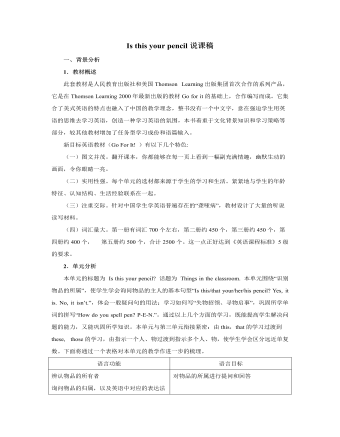
人教版新目标初中英语七年级上册Is this your pencil说课稿
教师准备利用录音使学生学习一些物品名词,并引导学生进行Pair work,学会询问“What’s this? It's a … . How do you spell watch? W-A-T-C-H.”;引导学生写“寻物启事”和“失物招领”,画图猜测物品,巩固所学内容,培养学生动脑、动手的能力及拾金不昧的精神和助人为乐、团结友爱的品德。学生准备学习一些物品名词,了解写寻物启事和失物招领的内容和格式。1. Warming up考虑到大多数学生以前学过一部分单词,可以以猜谜语竞赛的形式导出本课内容. 以pencil为例:Step1: 说出谜面, 可以用汉语解释.Our little JohnHas a wooden shirt on, And a long, sharp nose.He leaves his mark wherever he goes.接着教师画一件物品如:baseball 问学生:What’s this? 让学生使用句型 Is this a/an…?进行猜测。2. Group work学生分成四人或六人小组,将本单元的单词画出来加以猜测并评出最佳图画和最佳猜词者。3. Read ,circle and write1) Ask students to look back at page 10 . Have students read the list of the words . 2) Look at the Section B 3a . 3) Check the answers by having one student read his or her circled answers . Answers : computer game , ring , ID card , watch 4) Page 11 3b . this activity provide guided reading practice using the target language . Teacher told students that they are in the wrong order . when they are in the right order , they will make a clear message .
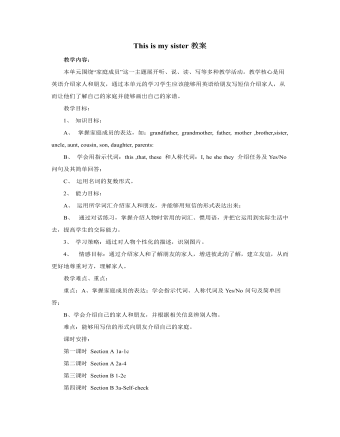
人教版新目标初中英语七年级上册This is my sister教案
(Play the recording twice again.) (Check the answer.) ③Pairwork. Draw your own picture and talk about it. T: We find out the picture of Lin Hai’s family. Can you draw a picture of your family? SS: … T: OK. When you finish drawing, tell your partner about your picture. You can use “This is …” and “ These are …” to talk about. Then report it to the class. (Students work.) (Check students’ work. Ask two or three students to report.) Step Three: Task. Talk about the family tree. T: Look at the family tree. I think it’s a big family. You can do it in groups of four or three. You can do it in pairs or only by yourself. Then report it to the class. (Students work. Teacher walks around in the classroom and helps the students.) T: Stop here. Let’s check it out. (Choose students to do it.) S1: Look at my family tree. This is my… This is my … They have two … This is my … This is my …This is my …This is my. My parents have two children. This is…This is my …My uncle and my aunt have a son. He is my … (Ask two more students to do it.) Homework. Write a passage about your family.
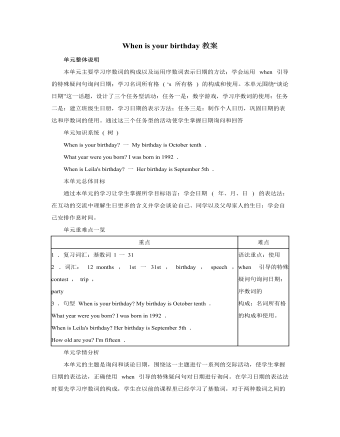
人教版新目标初中英语七年级上册When is your birthday教案
本单元主要学习名词所有格 ('s 所有格 ) 的构成和使用。在初次接触 “ 名词所有格 ” 时,学生较难理解的可能是 “ 所有格 ” 这个名称,对于它的构成,学生也许会觉得较容易。教师可通俗地告诉学生 “ 所有格 ” 的意思是表示 “…… 的 ” ,这样学生反而容易接受。在使用 “ 名词所有格 ” 形式时,学生容易犯错误或混淆的主要是:将这种一 's 构成形式与 is 的缩写形式混淆,如: My father's name's Jin Zhi .,可以这样告诉学生:名词所有格的后面一般应接名词;勿将这种一 's 结构盲目套用与人称代词上,代替物主代词使用,如 He's father's name is Li Cheng 。在教学初期,可不讲授名词所有格的其它形式,待时机成熟,再向学生介绍复数名词所有格形式的结构一 ' ,如: the students' bikes 。 Self Check 教学内容 Self Check( 教材 P52) 教学目标 知识与能力 复习词汇 birthday , date , month , January , February , March , April , May , June , July , August , September , October , November , December , date , birth , age , old , speech . contest . trip , party , event , an , festival , pop , concert , chorus , lecture , music ;引导学生复习、巩固“询问和谈论日期”的目标语言并运用所学知识安排活动。
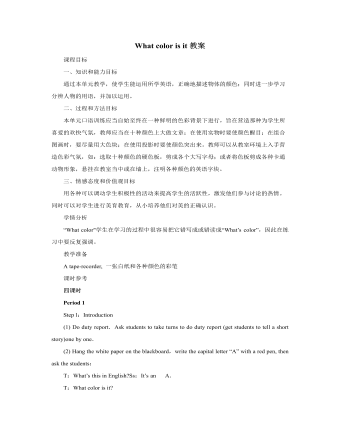
人教版新目标初中英语七年级上册What color is it教案
一、知识和能力目标通过本单元教学,使学生能运用所学英语,正确地描述物体的颜色;同时进一步学习分辨人物的用语,并加以运用。二、过程和方法目标本单元口语训练应当自始至终在一种鲜明的色彩背景下进行,旨在营造那种为学生所喜爱的欢快气氛,教师应当在十种颜色上大做文章;在使用实物时要使颜色醒目;在组合图画时,要尽量用大色块;在使用投影时要使颜色突出来。教师可以从教室环境上入手营造色彩气氛,如:选取十种颜色的硬色板,剪成各个大写字母;或者将色板剪成各种卡通动物形象,悬挂在教室当中或在墙上,注明各种颜色的英语字块。三、情感态度和价值观目标用各种可以调动学生积极性的活动来提高学生的活跃性,激发他们参与讨论的热情。同时可以对学生进行美育教育,从小培养他们对美的正确认识。
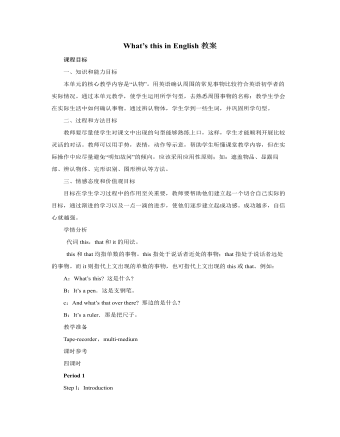
人教版新目标初中英语七年级上册What’s this in English教案
一、知识和能力目标本单元的核心教学内容是“认物”。用英语确认周围的常见事物比较符合英语初学者的实际情况。通过本单元教学,使学生运用所学句型,去熟悉周围事物的名称;教学生学会在实际生活中如何确认事物。通过辨认物体,学生学到一些生词,并巩固所学句型。二、过程和方法目标教师要尽量使学生对课文中出现的句型能够熟练上口,这样,学生才能顺利开展比较灵活的对话。教师可以用手势,表情,动作等示意,帮助学生听懂课堂教学内容,但在实际操作中应尽量避免“明知故问”的倾向,应该采用应用性原则;如:遮盖物品、显露局部、辨认物体、完形识别、图形辨认等方法。三、情感态度和价值观目标目标在学生学习过程中的作用至关重要,教师要帮助他们建立起一个切合自己实际的目标,通过渐进的学习以及一点一滴的进步,使他们逐步建立起成功感。成功越多,自信心就越强。
Is this your pencil教案
教学内容
本单元围绕着“Is this your pencil?”这一主题开展听、说、读、写等多种教学活动,其教学核心内容是“确认物主”。通过本单元的教学,使学生学会辨认物品的所有者,学会根据场景询问物品的所属,以及英语中对应的表达法,学会写寻物启事和失物招领。教师应着力培养学生能在日常交际交往中有效地使用语言进行表达,与他人沟通信息,为今后学习打下坚实的语言基础.

教学目标
1)知识目标:A.学习并掌握指示代词: this、 that;
B.学习What引导的特殊疑问句;
C.学会Yes/No问句及其简单回答;
D.学会句型:---How do you spell pen? P-E-N.
2)能力目标:A.能辨认物品的所有者;
B.根据不同场景,能用英语对物品的所属进行提问和回答;
C.能识别不同句式的语调(陈述句,疑问句);
D.培养学生听、说、读、写的能力及创新思维能力.
3)情感目标:A.通过寻找主人的游戏和失物招领等活动,培养学生拾金不昧的良好的品德及健康向上的人格;
B.通过开展小组活动,指导学生积极与他人合作,相互学习、相互帮助,共同完成学习任务.
教学重点、难点
重点:A.掌握批示代词this、 that用法;
B.掌握特殊疑问句和Yes/No问句及其简单回答.
难点:学会写寻物启事和失物招领.
课时安排
第一课时 Section A 1a-1c
第二课时 Section A 2a-4b
第三课时 Section B 1a-2c
第四课时 Section B 3a-4Self-check 1-3
Period One
课前准备
教师:录音机,图片,物品实物.
学生:实物(学习用品).
教学设计
Step One: Warming up.(通过复习形容词性物主代词,把学生引入学习英语的
情境中。)
Learn the chant.
T:Let’s sing the chanttogether.
my 是我的,your是你的,男他的是his,女她的是her; 名词前面常站岗,限定所
属有功劳.
Step Two: New words.(利用实物教学,使得教学过程自然、形象。)
1. Present the newwords.
T:Boys and girls, lookat this please. What’s this in English?
(Teacher holds a pen inthe English.)
S1:A pen.(Ss may say itin English.)
T:Yeah.It’s a pen.Andwhat’s this?
(The teacher holds aneraser in the hand.)
S2:It’s an eraser.
(Teach the other wordssuch as “pencil, book, eraser, ruler, pencil case, backpack, pencil sharpener,and dictionary” in the same way.)
2. Practice the newwords.
T:Now,please look atthe pictures in your books. Can you put the words with the objects in the rightpictures? Write the letters next to the words, please.(Give Ss about two minutesto finish 1a.)
T:OK,let’s check theanswers.Who can tell us the answers?
S2:…
Step Three: Present thedrills.
1. Present the drill“Is this…?Yes/No,it is/isn’t.”(利用实物引入句型,使用不同人的物品来引入形容词性物主代词和名词的搭配的用法。)
(Hold the teacher’spen.)
T:This is my pen.Is thisyour pen?
S1:No,it isn’t.It’syour pen.
T:(Hold the student’spen.) This is your pen. Is this your pen?
S1:Yes,it is. It’s mypen.
T:(Hold a girl’s pen.)This is her pen. Is this your pen?
S1:No,it isn’t.It’s herpen.
T:(Hold a boy’s pen.) Thisis his pen. Is this your pen?
S1:No,it isn’t. It’shis pen.
T:Thank you.
2. Practice the drill“Is this your…?” in pairs with your own school things.Pay attention to the useof my, your,his or her.(利用学习用品操练句型,并加深对物主代词的理解。)
S3:Is this your…?
S4:…It’s my…
S3:Is this…?
S4:…It’s his/her…
(The teacher asks a fewpairs to practice.)
3. Present the drill“Is that …? Yes/ No, it is/isn’t.”(利用教师所站位置的不同来引入批示代词that的用法,并从位置关系上让学生准确理解this ,that的区别。)
T:That is my book. Isthat my book?
(Put a book on theteacher’s table so that the Ss can see it clearly, and the teacher stands alittle far from the table.)
S5:Yes, it is .It’syour book.
T:That is his book.Isthat your book?
(Put a boy’s book onthe table and the teacher in the same place.)
S5:No, it isn’t.It’shis book.
T:That is her book.Isthat your book?
(Put a girl’s book onthe table and the teacher in the same place.)
S5:No,it isn’t.It’s herbook.
(Teach and practice thedrill “Is that …?” and its answer.)
4. Practice the drill“Is that your…?” in pairs with your own school things.(通过练习,区别两个批示代词的用法。)
S6:Is that your…?
S7:… It’s my ….
S6:Is that your…?
S7: …It’s his/her…
(The teacher asks somepairs to practice.)
5. Listening.(进行听力练习,巩固所学的句型。)
T:Now please listen tothe three conversations,the first time you only listen.Then I play again. Andthis time you listen and number the conversations.
(Point to the boxes toshow where students write the numbers for the conversations.Teacher plays thetape and students listen to it and finish 1b.)
T:Let’s check theanswers, OK?
S8:(from left to right)
T:Thank you.
6. Practice the drillsaccording to the pictures using“his or her”.(设置情景,使学生在情景中准确运用物主代词his或her。)
(Show students fourpictures like the followings.见课件。)
Step Four: Task “Have acontest”.(把两个学生的文具混在一起,然后请他们分别挑出自己和同伴的物品,用的时间少者为胜者。挑选物品的同时,要求学生用英语说出:This is my…That isher/his…)
T:I’ll put your thingsand your friends’ things together.I want to see if you can identify which isyours and which is hers or his.
(Put the same number ofthe things together, and first ask them to pick out their own things and theirpartners’ things. Then ask them to give a report, using the key words andtarget language. One student picks up the things while the other counts thetime as well.)
Languages used for thetask:
1. This is my…
2. That is her/his…
Step Five: Summary.(编一个Chant ,便于学生进一步识记本节课所学的重点词汇和语言项目。注意应强调Chant 的节奏和一般疑问句的语调。)
Chant.
T: In this class, we’velearned the names of some common personal possessions and how to identifyownership. Let’s learn to say this chant.
Is this my book? Yes,it is.
Is that your ruler?No,it isn’t.
Is this her pencil?Yes, it is.
Is that his erase r?No,it isn’t.
Homework.
Read the new words andthe target languages presented in this class and say the chant to improve yourspoken English.
PeriodTwo
课前准备
教师:录音机,所学物品的图片,一个书包(里面装着事先收集的学习文具),表格若干张。
学生:一张硬纸写上自己的姓名和电话号码,学习的物品。
教学设计
Step One: Revision.
1. Review the drills.(用学生的姓名和电话号码来复习句型:Is this (that) your (his/her)…?及简短回答:Yes, it is./No, itisn’t.注意教师提问的同时,用手势来帮助学生给出你预想的答案。)
(Put some paper withthe names and telephone numbers on the blackboard.)
T: Please look at theblackboard. And answer my questions , please . Is this your first name?
S1: No , it isn’t.
T: Is that her lastname?
S2: Yes, it is.
T: Is this histelephone number?
S3: Yes, it is.
T: Good. This time, whowould like to come to the blackboard and ask questions like me?
(Students in turn cometo the blackboard, point to the paper and ask questions, then ask otherstudents to answer.)
2. Review thevocabulary.(在黑板的名字旁边贴上学习物品的图片,来复习所学的单词和句型。)
(Put some pictures ofthings students have learned in class next to the names of the students.)
T: Is this your ruler?(Point to Picture 1.)
S4: No,it isn’t.
T: Is this her ruler? (Pointto Jenny Chen.)
S4: Yes, it is.
T: Is that your pencilcase? (Point to Picture 2.)
S5: No, it isn’t.
T: Is that his pencilcase ? ( Point to Jim Wang.)
S5: Yes, it is.
(Get the students toask the questions in turn, make sure they use the items they like.)
Step Two: Listining.
1. Listening (2a). (练习听力前,先让学生再一次说出图片中物品的英文,进一步强化重点单词。)
T: Please look at thepictures in 2a. Can you say their English name? (Teacher asks the students toname each one individually.)
S6: This is…
S7: This is …
……
T: Now please take outthe objects in 2a and put them on the desk. You will listen a dialogue andplease pick up the things you hear. Let’s see who will do fastest and best.
( Play the recordingfor the students to listen.) (让学生把听到的物品选出来,放在自己的桌子上,让学生动手去做,比单纯的单词辨听更易引起学生学习的兴趣。)
T: Now let’s check the answers.Please hold the things you hear and say their English names,OK?
(Make sure studentshold the things to show them to the other students.)
S8: Pencil.
S9: ……
2. Listening (2b). (进一步强化重点词汇后,进行听力练习,要求完成单词的拼写。)
T: Now please read thewords. One holds the things, the others read them aloud one by one.
(One student holds thethings, and the other students say the words aloud.)
T: This time you willlisten to the recording again, and you will write one of the words from the boxon each blank line.
(Play the recording.Students listen and complete the conversation.)
T: Let’s check theanswers. I’d like to ask three students to read the conversation in role.
(Three students readthe conversation, filling the missing words. The rest of the students checktheir answers.)
Step Three: New drills.
1. Present the newdrills. (用实物引入新句型,帮助学生用正确的句子来回答。)
(The teacher showsstudents a pencil.)
T: What’s this inEnglish?
S: It’s a pencil.
T: How do you spell it?
S: P-E-N-C-I-L.
(Change an eraser. Askand answer in the same way.)
2. Practice the drills.(学生分组练习新句型。)
T: Now please practicethe conversation with your partner. Use the words shown in 3a.
SA: What’s this inEnglish?
SB: It’s a ruler.
SA: How do you spell it?
SB: R-U-L-E-R.
(As students practice,the teacher moves around the classroom checking progress and offeringpronunciation and intonation support as needed.)
T: I’ll ask some pairsof students to practice the conversations.
SA: …
SB: …
3. Play the game : Aspelling game. (进行一个拼写游戏比赛,进一步操练新句型。)
T: Now let’s play aspelling game. We divide our class into two groups. Each team will take turnsasking the other group to the spell we learned in class. The team who is thefirst to get ten points is the winner. Let’s start.
SA: How do you spellbackpack?
SB: B-A-C-K-P-A-C-K.
T: Group B, one point.It’s your turn to ask, please.
Step Four: Task 2: Findthe owner. (此任务主要进行了听、说、写的训练,并复习了一般疑问句及其简短的回答,以及物主代词的用法。)
T: I have some things.But I’m sorry I don’t know whose these are. Could you help me find the owers ?Let’s see who can find all the owners first and write the owners’ names in thechart.
Language used for thetask:
1. Is this your mathbook?
Yes, it is. It’s mymath book.
2. Is that your ruler?
No, it isn’t. It’s herruler. My ruler is blue.
3. Kim, is this yourdictionary?
Yes, it is. It’s mydictionary.
Here you are.
Thank you.
Step Five: Summary andhomework.(录音作业,要求学生使用准确的语调来读一般疑问句和特殊疑问句。)
In this class, we’velearned what, how and yes-no questions mainly. And we also revised thepossessive adjectives and key words.
After class, pleasepractice what, how and yes-no questions using their own possessions with yourpartner. When you say the conversation fluently, tape records some of them andthen play.
2)Discuss about thedifferences between English names and Chinese names.(通过小组讨论、总结的方式进行,使学生掌握中英文名字的异同。)
Teacher: Thank you foryour job. I think they are all good English names. For example,“Susan” is afirst name. “Brown” is a last name. “Susan Brown” is a beautiful girl’sname.Who wants to have this name?
A: I do.
T:OK. Now you have anEnglish name Susan Brown. And your Chinese name is Sun Ping.Can you find thedifferences between them? Let’s look at the next two pictures and have adiscussion about the differences between Chinese names and English names.
A boy: Im a Chineseboy. My name is Zhang Nan. Zhang is my first name. Its also my family name.Nan is my last name. Its also my given name.
A girl: Im Mary Brown.Im English. Mary is my first name.
Brown is last name.Parents usually call me Mary Brown. But
I like to be calledMiss Brown.
3)Exchange theinformation.(需要在课前有所准备的情况下进行。)
Teacher: Now everyonecan choose an English name.But you must
pay attention to itsmeaning.For example,Susan means Molihua
in Chinese. Do you knowThe meanings of your names? If you do,
please exchange theinformation in your group.
4)Report the result tothe class.
(Some students areasked to give a report to the class.)
Example:
Sa: Im Rose White.Rose is my first name. White is my last name.
Rose is a kind ofbeautiful flower. In Chinese it means Meigui.
I like my name becauseI like roses very much. And maybe parents
call me Rose becausethey want me to be beautiful.
Homework.
Ask the students to sumup the meanings of English names after
class. They can readbooks or search the internet.
PeriodThree
课前准备
教师:录音机,图片,实物。
学生:实物。
教学设计
Step One: Revision.(让学生放录音作业,选择两个最好的,给予奖励,从而帮助学生树立学习的信心。)
T: Let’s listen to thetapes you recorded. Who is the best? OK, let’s start.
(Select the best two.Award a prize to their work.)
Step Two: New words.
1. Present the newwords. (运用多媒体或图片,教新的重点词汇,同时复习了本单元重点句型;在教学新单词的同时,注意复习刚学过的单词。)
T: Look at the picture.
(Show students apicture of a watch.)
T: What’s this inEnglish? It’s a watch.
(Ask a student) What’sthis in English?
S1: It’s a watch.
T: Good. (Ask anotherstudent.) What’s this in English?
S2: It’s a watch.
T: How do we spellwatch? (Show students the spelling.)
W-A-T-C-H, watch. Readafter me, please.
S3: W-A-T-C-H, watch.
(Teach the other words“baseball, computer game, key, notebook, ring and ID card” in the same way.)
T: Let’s say the wordsagain. What’s this in English?
(Show the words random.Ask questions like this.)
S4: It’s a key.
T: How do you spell it?
S4: K-E-Y.
2. Practice the newwords.(此活动练习了学生们的口语,同时又进一步巩固了新单词和已学句型。)
T: Good. Please look atthe pictures in 1a. Match the words with the things in the picture. Do it byyourself.(Students find them in the pictures and objects in the picture.)
T: Well, let’s checkthe answers. Who can tell us the answers?
S5: …
T: Now please work withyour partner, say the conversation in 1b. Use the pictures in 1a.
(Students practice theconversation. As students work, the teacher moves around and help them.)
Step Three: Listening.
1. Listening (2a).(通过听力练习,加深对所学单词的记忆。)
T: Listen to theconversation. Pay special attention to the names of objects. You will hear someof the names, not all of them. Circle on the picture each item whose name ismentioned in the conversations.
(Play the recordingtwice. Students listen and circle the items.)
T: Let’s check theanswers, OK?
S6: …
T: Who would like tosay the circled words again?
S7: …
2. Listening(2b).(通过听力练习,强化学生对单词和句型的理解,同时训练学生写的技能。)
T: Please look at thetwo pictures in 2b. One is Kelsey, and the other is Mike. Listen to theconversations again. This time you will pay attention to the things Kelsey andMike are looking for. Then write down the names of the things under eachperson’s pictures.
(Play the recording forthe students to write down the words.)
T: Well, what is Kelseylooking for?
S8: …
T: What about Mike?What is he looking for?
S9: …
Step Four: Pair work.(这个活动运用信息差,训练了学生用重点词汇和句型进行听、说、写的练习。)
T: Now let’s play agame. You are Student A and your partner is Student B. Student A looks at page81, while Student B looks at page 82. Each student has only part of theinformation needed to complete the activity. First Student A asks Student Bquestions, using the words in the box; Student B answers the questions andwrites the words in the chart below.
(Students practice inpairs, asking and answering questions and filling the charts. And the teachermoves around explaining the procedure and of fering help.)
A sample:
SA: Is this her pencilcase ? SB: No, it isnt. Its his pencil case. SA: Is this his key? SB: Yes, itis. Its his key. SA: Is this his backpack? SB: No, it isnt. Its her backpack.
(Students practice inpairs.)
T: This time Student Basks Student A questions, using the words in the box; Student A answers thequestions and writes the words in the chart below.
(Students practice inpairs, asking and answering questions and filling the charts. And the teachermoves around explaining the procedure again and providing help.)
SB: Is this her pen?SA: No, it isnt. Its his pen. SB: Is this her book? SA: Yes, it is. Its herbook. SB: Is this his computer game? SA: No, it isnt. Its her computer game.
T: Let’s check theanswers. One from Group A and the other from Group B come to the blackboard tofill in the chart.
Step Five: Summary andhomework.
In this case, we’velearned the names of some possessions. After class, please use some of thesewords to write out a conversation and practice with your partner.
PeriodFour
课前准备
教师:录音机,图片,录好的磁带,教学课件。
学生:收集一些英文的失物招领。
教学设计
Step One: Revision.(检查学生的作业,找几组学生表演,训练学生的口语表达能力。)
T: First I’ll checkyour homework. Practice the dialogue you made. And you should use the picturesor the objects that are mentioned in your dialogue. I’ll invite some of you tocome to the front to say the dialogue.
预览结束,下载后可阅读高清完整版文档
立即下载
转载请注明出处!本文地址:
https://www.lfppt.com/worddetails_7998274.html最新课件教案文档
-

精选高中生期末评语
1、该生学习态度端正 ,能够积极配合老师 ,善于调动课堂气氛。 能够积极完成老师布置的任务。学习劲头足,听课又专注 ,做事更认 真 ,你是同学们学习的榜样。但是,成绩只代表昨天,并不能说明你 明天就一定也很优秀。所以,每个人都应该把成绩当作自己腾飞的起 点。2、 你不爱说话 ,但勤奋好学,诚实可爱;你做事踏实、认真、为 人忠厚 ,是一个品行端正、有上进心、有良好的道德修养的好学生。在学习上,积极、主动,能按时完成老师布置的作业,经过努力 ,各 科成绩都有明显进步,你有较强的思维能力和学习领悟力,学习也有 计划性,但在老师看来,你的潜力还没有完全发挥出来,学习上还要有持久的恒心和顽强的毅力。
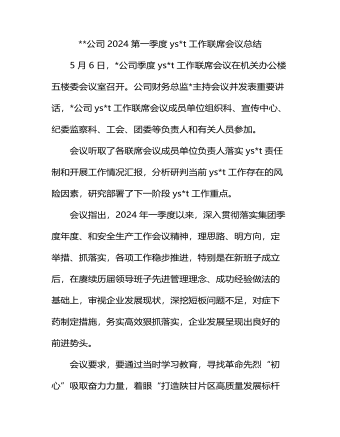
公司2024第一季度意识形态工作联席会议总结
一是要把好正确导向。严格落实主体责任,逐条逐项细化任务,层层传导压力。要抓实思想引领,把理论学习贯穿始终,全身心投入主题教育当中;把理论学习、调查研究、推动发展、检视整改等有机融合、一体推进;坚持学思用贯通、知信行统一,努力在以学铸魂、以学增智、以学正风、以学促干方面取得实实在在的成效。更加深刻领会到******主义思想的科学体系、核心要义、实践要求,进一步坚定了理想信念,锤炼了政治品格,增强了工作本领,要自觉运用的创新理论研究新情况、解决新问题,为西北矿业高质量发展作出贡献。二是要加强应急处事能力。认真组织开展好各类理论宣讲和文化活动,发挥好基层ys*t阵地作用,加强分析预警和应对处置能力,提高发现力、研判力、处置力,起到稳定和引导作用。要坚决唱响主旋律,为“打造陕甘片区高质量发展标杆矿井”、建设“七个一流”能源集团和“精优智特”新淄矿营造良好的舆论氛围。三是加强舆情的搜集及应对。加强职工群众热点问题的舆论引导,做好舆情的收集、分析和研判,把握时、度、效,重视网上和网下舆情应对。
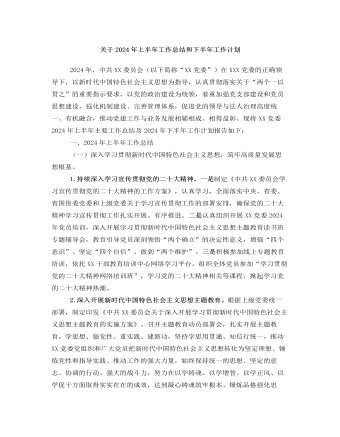
关于2024年上半年工作总结和下半年工作计划
二是深耕意识形态。加强意识形态、网络舆论阵地建设和管理,把握重大时间节点,科学分析研判意识形态领域情况,旗帜鲜明反对和抵制各种错误观点,有效防范处置风险隐患。积极响应和高效落实上级党委的决策部署,确保执行不偏向、不变通、不走样。(二)全面深化党的组织建设,锻造坚强有力的基层党组织。一是提高基层党组织建设力量。压实党建责任,从政治高度检视分析党建工作短板弱项,有针对性提出改进工作的思路和办法。持续优化党建考核评价体系。二是纵深推进基层党建,打造坚强战斗堡垒。创新实施党建工作模式,继续打造党建品牌,抓实“五强五化”党组织创建,广泛开展党员教育学习活动,以实际行动推动党建工作和经营发展目标同向、部署同步、工作同力。三是加强高素质专业化党员队伍管理。配齐配强支部党务工作者,把党务工作岗位作为培养锻炼干部的重要平台。
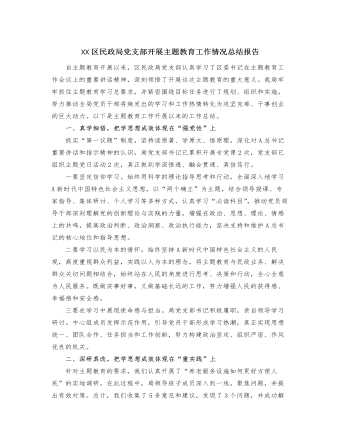
XX区民政局党支部开展主题教育工作情况总结报告
二要专注于解决问题。根据市委促进经济转型的总要求,聚焦“四个经济”和“双中心”的建设,深入了解基层科技工作、学术交流、组织建设等方面的实际情况,全面了解群众的真实需求,解决相关问题,并针对科技工作中存在的问题,采取实际措施,推动问题的实际解决。三要专注于急难愁盼问题。优化“民声热线”,推动解决一系列基层民生问题,努力将“民声热线”打造成主题教育的关键工具和展示平台。目前,“民声热线”已回应了群众的8个政策问题,并成功解决其中7个问题,真正使人民群众感受到了实质性的变化和效果。接下来,我局将继续深入学习主题教育的精神,借鉴其他单位的优秀经验和方法,以更高的要求、更严格的纪律、更实际的措施和更好的成果,不断深化主题教育的实施,展现新的风貌和活力。

交通运输局在巡回指导组主题教育阶段性工作总结推进会上的汇报发言
今年3月,市政府出台《关于加快打造更具特色的“水运XX”的意见》,提出到2025年,“苏南运河全线达到准二级,实现2000吨级舶全天候畅行”。作为“水运XX”建设首战,谏壁闸一线闸扩容工程开工在即,但项目开工前还有许多实际问题亟需解决。结合“到一线去”专项行动,我们深入到谏壁闸一线,详细了解工程前期进展,实地察看谏壁闸周边环境和舶通航情况,不断完善施工设计方案。牢牢把握高质量发展这个首要任务,在学思践悟中开创建功之业,坚定扛起“走在前、挑大梁、多做贡献”的交通责任,奋力推动交通运输高质量发展持续走在前列。以学促干建新功,关键在推动高质量发展持续走在前列。新时代中国特色社会主义思想着重强调立足新发展阶段、贯彻新发展理念、构建新发展格局,推动高质量发展,提出了新发展阶段我国经济高质量发展要坚持的主线、重大战略目标、工作总基调和方法论等,深刻体现了这一思想的重要实践价值。
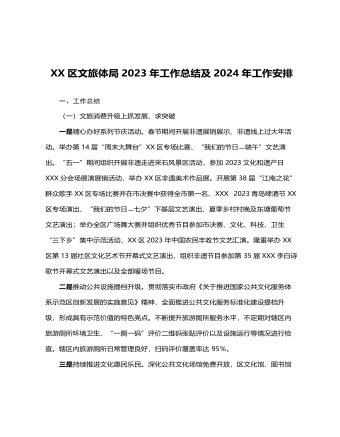
XX区文旅体局2023年工作总结 及2024年工作安排
三、2024年工作计划一是完善基层公共文化服务管理标准化模式,持续在公共文化服务精准化上探索创新,围绕群众需求,不断调整公共文化服务内容和形式,提升群众满意度。推进乡镇(街道)“114861”工程和农村文化“121616”工程,加大已开展活动的上传力度,确保年度目标任务按时保质保量完成。服务“双减”政策,持续做好校外培训机构审批工作,结合我区工作实际和文旅资源优势,进一步丰富我市义务教育阶段学生“双减”后的课外文化生活,推动“双减”政策走深走实。二是结合文旅产业融合发展示范区,全力推进全域旅游示范区创建,严格按照《国家全域旅游示范区验收标准》要求,极推动旅游产品全域布局、旅游要素全域配置、旅游设施全域优化、旅游产业全域覆盖。
今日更新Word
-

精选高中生期末评语
1、该生学习态度端正 ,能够积极配合老师 ,善于调动课堂气氛。 能够积极完成老师布置的任务。学习劲头足,听课又专注 ,做事更认 真 ,你是同学们学习的榜样。但是,成绩只代表昨天,并不能说明你 明天就一定也很优秀。所以,每个人都应该把成绩当作自己腾飞的起 点。2、 你不爱说话 ,但勤奋好学,诚实可爱;你做事踏实、认真、为 人忠厚 ,是一个品行端正、有上进心、有良好的道德修养的好学生。在学习上,积极、主动,能按时完成老师布置的作业,经过努力 ,各 科成绩都有明显进步,你有较强的思维能力和学习领悟力,学习也有 计划性,但在老师看来,你的潜力还没有完全发挥出来,学习上还要有持久的恒心和顽强的毅力。

××县招商局2024年上半年工作总结
二是全力推进在谈项目落地。认真落实“首席服务官”责任制,切实做好上海中道易新材料有机硅复配硅油项目、海南中顾垃圾焚烧发电炉渣综合利用项目、天勤生物生物实验基地项目、恺德集团文旅康养产业项目、三一重能风力发电项目、中国供销集团冷链物流项目跟踪对接,协调解决项目落户过程中存在的困难和问题,力争早日实现成果转化。三是强化招商工作考核督办。持续加大全县招商引资工作统筹调度及业务指导,贯彻落实项目建设“6421”时限及“每月通报、季度排名、半年分析、年终奖励”相关要求,通过“比实绩、晒单子、亮数据、拼项目”,进一步营造“比学赶超”浓厚氛围,掀起招商引资和项目建设新热潮。四是持续优化园区企业服务。

“四零”承诺服务创建工作总结
(二)坚持问题导向,持续改进工作。要继续在提高工作效率和服务质量上下功夫,积极学习借鉴其他部门及xx关于“四零”承诺服务创建工作的先进经验,同时主动查找并着力解决困扰企业和群众办事创业的难点问题。要进一步探索创新,继续优化工作流程,精简审批程序,缩短办事路径,压缩办理时限,深化政务公开,努力为企业当好“保姆”,为群众提供便利,不断适应新时代人民群众对政务服务的新需求。(三)深化内外宣传,树立良好形象。要深入挖掘并及时总结作风整顿“四零”承诺服务创建工作中形成的典型经验做法,进一步强化内部宣传与工作交流,推动全市创建工作质效整体提升。要面向社会和公众庄严承诺并积极践诺,主动接受监督,同时要依托电台、电视台、报纸及微信、微博等各类媒体大力宣传xx队伍作风整顿“四零”承诺服务创建工作成果,不断扩大社会知情面和群众知晓率。
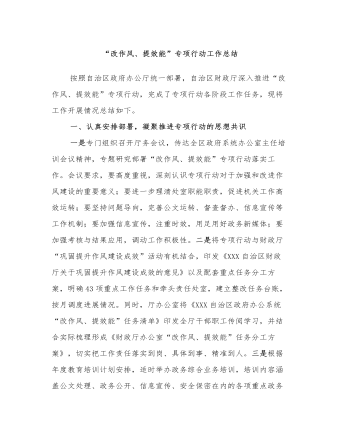
“改作风、提效能”专项行动工作总结
(五)服务群众提效能方面。一是政府采购服务提档升级。建成“全区一张网”,各类采购主体所有业务实现“一网通办,提升办事效率;全面实现远程开标和不见面开标,降低供应商成本;要求400万元以上工程采购项目预留采购份额提高至采购比例的40%以上,支持中小企业发展。2022年,我区政府采购荣获”中国政府采购奖“,并以全国第一的成绩获得数字政府采购耕耘奖、新闻宣传奖,以各省中第一的成绩获得年度创新奖。二是财政电子票据便民利民。全区财政电子票据开具量突破1亿张,涉及资金810.87亿元。特别是在医疗领域,全区241家二级以上公立医疗机构均已全部上线医疗收费电子票据,大大解决了群众看病排队等待时间长、缴费取票不方便的问题,让患者”省心、省时、省力“。
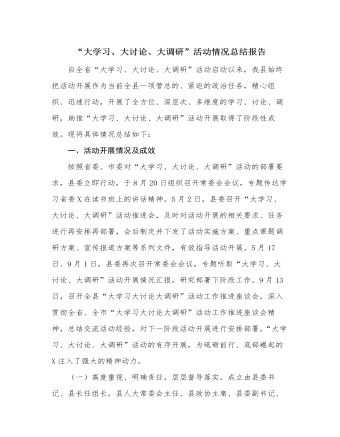
“大学习、大讨论、大调研”活动情况总结报告
一、活动开展情况及成效按照省委、市委对“大学习、大讨论、大调研”活动的部署要求,县委立即行动,于8月20日组织召开常委会会议,专题传达学习省委X在读书班上的讲话精神。5月2日,县委召开“大学习、大讨论、大调研”活动推进会,及时对活动开展的相关要求、任务进行再安排再部署,会后制定并下发了活动实施方案、重点课题调研方案、宣传报道方案等系列文件,有效指导活动开展。5月17日、9月1日,县委再次召开常委会会议,专题听取“大学习、大讨论、大调研”活动开展情况汇报,研究部署下阶段工作。9月13日,召开全县“大学习大讨论大调研”活动工作推进座谈会,深入贯彻全省、全市“大学习大讨论大调研”活动工作推进座谈会精神,总结交流活动经验,对下一阶段活动开展进行安排部署。“大学习、大讨论、大调研”活动的有序开展,为砥砺前行、底部崛起的X注入了强大的精神动力。
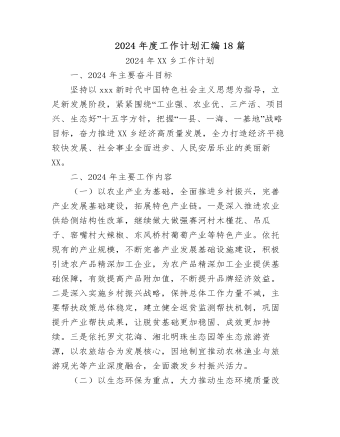
2024年度工作计划汇编(18篇)
1.市政基础设施项目5项,总建设里程2.13km,投资概算2.28亿元。其中,烔炀大道(涉铁)工程施工单位已进场,项目部基本建成,正在办理临时用地、用电及用水等相关工作;中铁佰和佰乐(巢湖)二期10KV外线工程已签订施工合同;黄麓镇健康路、纬四路新建工程均已完成清单初稿编制,亟需黄麓镇完成图审工作和健康路新建工程的前期证件办理;公安学院配套道路项目在黄麓镇完成围墙建设后即可进场施工。2.公益性建设项目6项,总建筑面积15.62万㎡,投资概算10.41亿元。其中,居巢区职业教育中心新建工程、巢湖市世纪新都小学扩建工程已完成施工、监理招标挂网,2月上旬完成全部招标工作;合肥职业技术学院大维修三期已完成招标工作,近期签订施工合同后组织进场施工;半汤疗养院净化和医用气体工程已完成招标工作;半汤疗养院智能化工程因投诉暂时中止;巢湖市中医院(中西医结合医院)新建工程正在按照既定计划推进,预计4月中下旬挂网招标。













 QQ登录
QQ登录 微信登录
微信登录